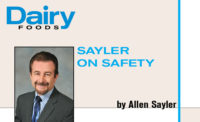How to manage the parade of auditors, inspectors in your dairy plant

When will the parade of inspectors/auditors end?” If you work for a dairy plant, you have probably asked that question at some point.
It is an all-to-familiar experience to prepare for and do damage control after inspections and audits from customers, private third-party certification programs (SQF, BRC, IFS and FSSC22000), state dairy inspectors, FDA Regional Milk Specialists and FDA District investigators.
Unfortunately the Global Food Safety Initiative’s promise of “once certified, accepted by all” has not been fully realized. Some large and medium-sized customers still continue to pile on additional audit requirements. Recognizing that this is the reality of our present world, what are ways to make the experience positive, minimizing disruption of plant operations?
Some keys to a successful inspection/audit outcome are:
Inspection or audit system familiarity. Each inspection or audit program has slightly different focuses, requirements and scoring priorities. Be pro-active and not a victim by having staff knowledgeable of the various inspection and audit programs affecting the plant.
Today, too few plant staffs have a working knowledge of state and FDA inspection requirements. Without this working knowledge, the plant has no basis for knowing if the inspector or auditor has exceeded their authority.
Inspections versus audits. Audits and inspections are very different in their philosophy and intent. Understanding these differences will allow you to be better prepared and increase the likelihood of a good outcome.
Inspections are intended to evaluate a dairy plant’s operations primarily based on criteria applicable to all dairy plants, regardless of size, equipment used and products. Inspection reports identify every observation found by an inspector, regardless of importance.
Audits also use general GMP-based requirements, but rely primarily on the plant’s own written food safety program to determine whether the plant is in conformance. In addition, audit reports are not intended to identify every observation of the auditor, but contain findings, which are patterns (that is, not one crack in one floor, but many cracks in many floors). Overall, audits are more thorough and require more preparation time than inspections.
Preparation. Conduct an internal “dry run” prior to the known or anticipated date of the inspection or audit to identify and correct shortcomings. Particularly for audits, assemble all written operational documents and supporting records and conduct an intense review to identify “process” shortcomings.
If the inspector or auditor identifies document or record shortcomings the plant did not find, the plant’s internal audit program is inadequate. Also, allowing shortcomings identified during internal “dry runs” or official inspections/audits to go unaddressed will eventually catch up to the plant through more frequent inspections and audits, product destruction, fines and general loss of goodwill on the part of the inspector or auditor.
Plant “behavior” during an inspection or audit. It is crucial that the plant manager demonstrate a cooperative attitude and immediately fix any shortcomings identified by an inspector or auditor, if at all possible. While some inspection and audit system reports will still identify all observations or findings, the act of immediately fixing these will enhance the inspector or auditor’s impression of the plant and will pay dividends in other areas, i.e. an acceptable versus an unacceptable final report.
Defending plant operations, written procedures and recordkeeping. The path of least resistance is to agree to all observations or findings of an inspector or auditor. If the plant believes its practices and programs meet the intent of the inspection or audit program, there should be no hesitation in challenging the inspector or auditor.
Some inspectors and auditors utilize confrontation and intimidation to support their view, even when these views are wrong. In all cases, the challenge needs to be done professionally, supported by well-thought-out and factual arguments.
The best approach is by asking questions. Example: “I could not find that requirement in your program. Could you show me where this is so I can inform my management?” instead of “This is ridiculous and we have never had to do this before!”
Direct confrontation by the plant manager is a sure path to alienating any inspector or auditor resulting in a negative audit report.
Inspection or audit follow-up. Communication, preferably by electronic or hard copy letters to the inspector or auditor or their management conveys an attitude of compliance by the plant.
This communication can simply be an acknowledgement of the inspection or audit. It can also be expanded to challenge items in the report and provide justification as to why the plant disagrees with the report. For government inspections, written follow-up is crucial to minimizing the possibility of regulatory penalties (hearing, fines, product destruction, etc.)
In summary, the parade of inspectors and auditors in dairy plants is not likely to disappear any time soon. Until that day does arrive, it is important to provide plant resources to ensure a “culture of compliance.”
Looking for a reprint of this article?
From high-res PDFs to custom plaques, order your copy today!






